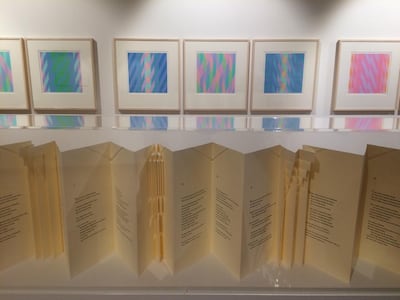Last year, at the time of his death, Palestinian artist Kamal Boullata had been at work on two new series of works, in painting and in silkscreens. Two books about him were about to be published – one, a volume of his writings edited by art historian Barry Flood, and another with critical essays on his work, edited by art history professor Burcu Dogramaci – and an exhibition and symposium were planned at the University of Cambridge, dedicated to exploring his contributions to Modern art. Boullata had never lacked for recognition during his life: he exhibited widely in the Middle East and internationally. He was well-known within Arab Modernism. But this convergence of events showed how the field, long side-lined, is beginning to be considered within the larger narrative of 20th-century art history.
And then, suddenly in August last year, he died.
"They did not hesitate a moment," says Lily Farhoud, Boullata's widow, about the conference organisers. "Elizabeth [Fowden] wrote to me: 'It is still going on, everyone wants to do the symposium,' and she insisted on finding the solution. It's so beautiful, so touching to feel that commitment. I'm very, very lucky."
The event at Cambridge, which was held last Friday, was shifted from being a series of papers in dialogue with Boullata himself to a symposium on his work, titled Jerusalem in Exile: Meaning and Abstraction in Arab and Islamic Art. The accompanying exhibition, which was supposed to be of one of his new series of screen-prints, pivoted to take in an important part of his practice that had long been overlooked: his artists' books; pamphlet-sized publications in which pages of poetry were cut, painted and folded. Some of these were accomplished as artistic projects, while others were gifts to his friends.

For John Berger, presenter of the seminal BBC series Ways of Seeing, Boullata made a series of visual and linguistic puns on the word "voir" (to see), turning the word into all its different possible formulations and playing with multiplicity of ways to see (Verses for John Berger, 2007). Boullata's architectural concertinaed book contains the poem Twelve Lanterns for Granada by Adonis, which the Syrian poet wrote after visiting the Alhambra with Boullata; Boullata, working with Farhoud's help, cut apart the corners of the paper into minute muqarnas, re-creating the palace's recursive geometric cornicing in the booklet's folds. The moving Qasidat al Ard / Al Layl (Ode to the Land / the Night, 2002), named after a lament by Mahmoud Darwish, trades Twelve Lanterns for Granada's strict geometry for entropy and emotion: splotches of deeply coloured China ink bleed across the book's heavy paper, and Boullata has handwritten the words to Darwish's poem across its pages.

The genre of artists' books was a natural fit for Boullata, who was deeply interested in poetry, and a writer of extraordinary breadth himself. In 2009, he wrote the first major study of Palestinian art, characteristically taking a long view of the subject and beginning the survey in the year 1850. He contributed numerous articles, some of which are collected in the new edited volume There Where You Are Not. Both this publication, as well as the book of essays on his work, Uninterrupted Fugue, were both launched on Friday, finishing two of the projects that Boullata himself did not live to see.
The conference itself had the feel of a memorial service for Boullata's ideas among a community of long-time supporters. Major names from the field of Arab art – Nasser Rabbat, Venetia Porter and Flood – gave papers; fellow Arab diaspora artists such as Dia Azzawi and Mohammad Omar Khalil, fresh from his own opening at the Mosaic Rooms, came to listen.
In her presentation to the symposium, British Museum curator Porter argued that Arab artists' bookmaking has been eclipsed by western examples. The modern practice of artists' bookmaking began in France with the collaboration in 1889 between the poet Paul Verlaine and the painter Pierre Bonnard – and the books made by French modern artists were vastly influential across the board, and particularly on Arab practitioners, who had their own tradition of calligraphy and hurufiyya, an aesthetic movement that married traditional Islamic calligraphy and modern art. Artists such as Azzawi, Etel Adnan, Shafic Abboud, Mona Saudi and Boullata himself made many artists' books in all forms – and for many, again like Boullata, Adonis was a core collaborator. This general neglect of this genre might be shifting, though: the current show about the Iraq war, Theater of Operations, at New York's MoMA PS1, focused on dafatir, or notebooks, of the kind made by Iraqi artists such as Azzawi during the embargo years or in exile. Warehouse421 currently has an exhibition of artists' bookmaking projects, such as the Kayfa Ta series by Maha Maamoun and Ala Younis.
The symposium sought to frame Boullata's work as part of a wider conversation around geometries and abstraction – two ideas so important to the story of art in the 20th century that carry particular valences in an Arab context. Boullata, a Christian Palestinian, is in some ways exemplary for thinking through meaning and abstraction in Arab and Islamic art. His work engages directly not only with history and religion, but with religions – a testament to the peaceful diversity of the Levant region.
As Fowden, the conference's organiser, recounted in her paper, Boullata could see the Dome of the Rock from the rooftop of where he grew up, in the Christian quarter of Jerusalem. He used to go and sit near it to copy the intricate, mathematically derived patterns on the tiles that make neat rows on its perimeter. The impact of these patterns can be felt on his paintings and screenprints made many years later – beautiful expression of the the Dome of the Rock's rich religious significance.
Jerusalem in Exile: Artist’s Books will be at Jesus College, Cambridge, UK, until March 13


